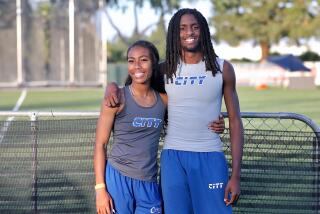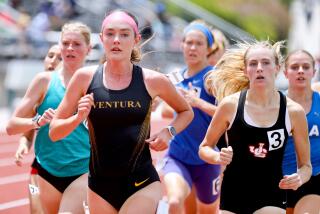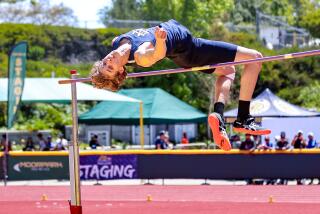TRACK AND FIELD : UCLA Makes Run for NCAA Title
With the outdoor season already under way, it is apparent that UCLA has another strong menâs team, at least on the dual meet and conference level.
The Bruins could also be a factor in the NCAA meet if some athletes recover from injuries and others develop as the season progresses.
In assessing his team, Coach Bob Larsen said that he has some proven athletes, such as Olympic 400-meter gold medalist Steve Lewis, along with weight men, throwers and jumpers.
âHowever, we may not have enough depth of quality sprinters for overall points, including the relays, at the NCAA level,â Larsen said.
As for USC, its season is dedicated to the NCAA meet. Ernie Bullardâs Trojans donât have enough depth to challenge UCLA in the dual, or Pacific 10 meets.
However, the Trojans have enough quality athletes to make some impact in the NCAA meet in June.
Last year, injuries to Lewis and other potential scorers prevented UCLA from winning a third consecutive NCAA championship. The Bruins finished sixth, after scoring 81 and 82 points in literally running away with the NCAA title in 1987 and 1988.
Since Larsen became UCLAâs coach in 1985, the Bruins have compiled a 45-0-1 dual meet record. Moreover, they will be favored to win their fourth consecutive Pac-10 championship, unprecedented since the conference was realigned in 1978.
UCLA would have been even stronger last year if quarter-miler Danny Everett and Henry Thomas had not left the team with eligibility remaining.
Everettâs departure was much like the current exodus of college football underclassmen into the NFL draft. Top track athletes are rewarded financially by competing internationally and some have lucrative shoe contracts.
Thomas is still in school, but has decided not to compete with the team.
Larsen anticipates that Brian Blutreich, Peter Thompson and John Knight will provide points in the NCAA meet as they did last year. Blutreich was third in the shotput and fourth in the discus. Thompson was third in the discus and Knight eighth in the hammer throw.
Knight was bothered by a back injury last year. Thatâs gone now, though, and he has already thrown the discus 212 feet, a personal best.
Among other Bruins with the potential to score at the national level are hurdler Derek Knight, long jumpers McArthur Anderson and Chuckie Brooks, distance runner Mark Dani and freshman javelin thrower Erik Smith.
Brooks is currently ineligible but is expected to regain his eligibility for the next school quarter, beginning in April.
Decathlete Joe Duarte is out for the season with a knee injury incurred in a motor scooter accident. Sprinter Derrick Baker is out indefinitely with a knee injury and javelin thrower Dave Bunevacz, who placed third in the Pac-10 meet in 1989, is inactive with a herniated disk.
USC has won 26 NCAA outdoor titles, substantially more than any other school. However, with NCAA track scholarship limitations imposing some hardship on private schools with high tuition costs, the Trojans havenât been much of a factor the last decade.
That was also compounded by some evaluating mistakes in recruiting.
âWeâre not a balanced team,â Bullard said. âOur team is basically an NCAA team and everything we do is a means to that ends.â
With selective recruiting, a team can be factor in the NCAA meet, even with small numbers, and thatâs USCâs goal now.
Bullardâs premier athletes are intermediate hurdler George Porter, who finished third in the NCAA meet last year; sprinter Quincy Watts, the former Taft High star who was injured at the end of the season, and newcomer Dietmar Haaf, the European indoor long jump champion from West Germany, and a transfer from the University of Stuttgart.
The Trojans lost a potential scorer in big meets when Luc Krotwaar of the Netherlands, a 3:40.8 1,500-meter runner, became homesick and left school.
Bullard believes that he can put together two quality relay teams that should score high in the NCAA meet.
His 400-meter team will be composed of Martin Cannady, a transfer from Long Beach City College, football players Calvin Holmes and Travis Hannah, and Watts.
Cannady, Hannah and Watts will be on the 1,600-meter team along with Porter.
Matt Gee, a linebacker on the football team, is a former high school record-holder in the javelin. However, the Trojans are thin in most field events.
Bob Kersee, UCLA womenâs track coach, says that his team has quality depth in all areas--and so it appears.
The Bruins certainly have the potential to win the NCAA championship with such talented athletes are Janeene Vickers, who won the 400-meter hurdles in the NCAA meet last year, heptathlete Tonya Sedwick, versatile weight performer Tracie Millett, middle distance runner Laura Chapel and freshman Angela Burnham, who won five state sprint titles while competing for Rio Mesa High in Oxnard.
âThis is the deepest team Iâve been associated with since, perhaps, the 1982-83 teams,â said Kersee, alluding to his championship teams.
USCâs womenâs team doesnât have the depth, nor as many quality athletes as UCLA.
The Trojan women will be depending mainly on intermediate hurdler Leslie Maxie, a 1988 Olympian, javelin thrower Ashley Selman, sprinter-long jumper Louan Guialdo, and sprinter Angela Rolfe.
Track Notes
Former distance runner Max Truex believes that some severe previous cases of heat prostration were the cause of his Parkinsonâs disease, although doctors rule out his theory. In any event, George Kiseda, a former editor at The Times, recalls that Truex and Bob Soth were both hospitalized after a 10,000-meter race of the U.S.-Soviet Union meet at Philadelphia in 1959. Track & Field Newsâ account of their condition at the time: âThe doctor who treated both Truex and Soth marveled at their recuperative powers and their physical condition. He said the oxygen, carbon dioxide, salt and fluid depletion that they had experienced would have been fatal to an average 30-year-old man.â
More to Read
Go beyond the scoreboard
Get the latest on L.A.'s teams in the daily Sports Report newsletter.
You may occasionally receive promotional content from the Los Angeles Times.






